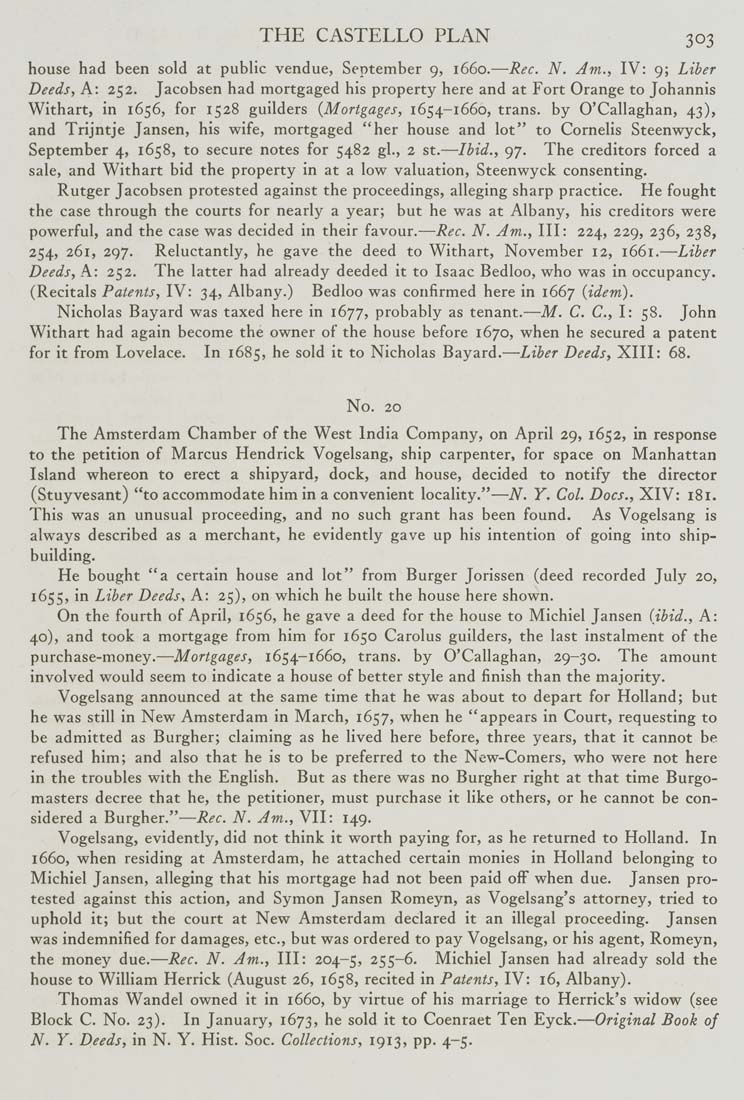THE CASTELLO PLAN 303
house had been sold at public vendue, September 9, 1660.—Rec. N. Am., IV: 9; Liber
Deeds, A: 252. Jacobsen had mortgaged his property here and at Fort Orange to Johannis
WIthart, in 1656, for 1528 guilders (Mortgages, 1654-1660, trans, by O'Callaghan, 43),
and Trljntje Jansen, his wife, mortgaged "her house and lot" to Cornells Steenwyck,
September 4, 1658, to secure notes for 5482 gl., 2 st.—Ibid., 97. The creditors forced a
sale, and Withart bid the property in at a low valuation, Steenwyck consenting.
Rutger Jacobsen protested against the proceedings, alleging sharp practice. He fought
the case through the courts for nearly a year; but he was at Albany, his creditors were
powerful, and the case was decided in their favour.—Rec. N. Am., Ill: 224, 229, 236, 238,
254, 261, 297. Reluctantly, he gave the deed to WIthart, November 12, 1661.—Liber
Deeds, A: 252. The latter had already deeded it to Isaac Bedloo, who was in occupancy.
(Recitals Patents, IV: 34, Albany.) Bedloo was confirmed here in 1667 (idem).
Nicholas Bayard was taxed here In 1677, probably as tenant.—M. C. C, I; 58. John
Withart had again become the owner of the house before 1670, when he secured a patent
for it from Lovelace. In 1685, he sold it to Nicholas Bayard.—Liber Deeds, XIII: 68.
No. 20
The Amsterdam Chamber of the West India Company, on April 29, 1652, in response
to the petition of Marcus Hendrick Vogelsang, ship carpenter, for space on Manhattan
Island whereon to erect a shipyard, dock, and house, decided to notify the director
(Stuyvesant) "to accommodate him in a convenient locality."—N. Y. Col. Docs., XIV: 181.
This was an unusual proceeding, and no such grant has been found. As Vogelsang is
always described as a merchant, he evidently gave up his intention of going into ship¬
building.
He bought "a certain house and lot" from Burger Jorissen (deed recorded July 20,
1655, in Liber Deeds, A: 25), on which he built the house here shown.
On the fourth of April, 1656, he gave a deed for the house to Michiel Jansen (ibid.. A:
40), and took a mortgage from him for 1650 Carolus guilders, the last instalment of the
purchase-money.—Mortgages, 1654-1660, trans, by O'Callaghan, 29-30. The amount
involved would seem to indicate a house of better style and finish than the majority.
Vogelsang announced at the same time that he was about to depart for Holland; but
he was still In New Amsterdam in March, 1657, when he "appears in Court, requesting to
be admitted as Burgher; claiming as he lived here before, three years, that it cannot be
refused him; and also that he is to be preferred to the New-Comers, who were not here
in the troubles with the English. But as there was no Burgher right at that time Burgo¬
masters decree that he, the petitioner, must purchase it like others, or he cannot be con¬
sidered a Burgher."—Rec. N. Am., VII: 149.
Vogelsang, evidently, did not think It worth paying for, as he returned to Holland. In
1660, when residing at Amsterdam, he attached certain monies in Holland belonging to
Michiel Jansen, alleging that his mortgage had not been paid off when due. Jansen pro¬
tested against this action, and Symon Jansen Romeyn, as Vogelsang's attorney, tried to
uphold It; but the court at New Amsterdam declared it an illegal proceeding. Jansen
was indemnified for damages, etc., but was ordered to pay Vogelsang, or his agent, Romeyn,
the money due.—Rec. N. Am., Ill; 204-5, 255-6. Michiel Jansen had already sold the
house to William Herrick (August 26, 1658, recited In Patents, IV; 16, Albany).
Thomas Wandel owned It in 1660, by virtue of his marriage to Herrick's widow (see
Block C. No. 23). In January, 1673, he sold it to Coenraet Ten Eyck.—Original Book of
N. Y. Deeds, In N. Y. Hist. Soc. Collections, 1913, pp. 4-5.
|








